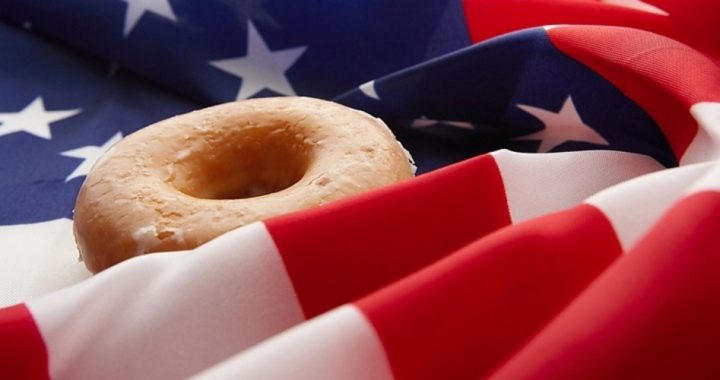
On Tuesday First Lady Michelle Obama joined with Agriculture Department Secretary Tom Vilsak at the White House to announce new USDA rules that will impact every student in every public school in the country, starting next year. The rules will require the phasing out of any advertising or marketing of foods that don’t meet the USDA’s current nutritional standards already in place at public schools. The thinking goes that if they can’t eat it, why advertise it? Said Mrs. Obama:
The idea here is simple: our classrooms should be healthy places where kids aren’t bombarded with ads for junk food.
Because parents are working hard to teach their kids healthy habits at home, their work shouldn’t be undone by unhealthy messages at school.
Vilsack provided the echo chamber: “If you can’t sell it, you ought not to be able to market it.”
The new rules will eliminate ads for Coca Cola, for example, but not for Diet Coke or Dasani. If Coca Cola has paid to have a scoreboard put up at a school — with its advertising on it — it won’t have to be torn down immediately but can stay in place until it’s upgraded with a new one. Ads for junk foods, such as candy bars, potato chips, and other treats deemed to be unhealthy by the FDA would be banned, no matter where they now might appear: banners, paper cups and napkins, wall posters, menu boards, anywhere the kids might be encouraged to indulge in such illegal behavior. At the moment, off-site events, such as fundraisers for the schools, would not be affected: The kids are still free to indulge in all manner of illegal eating there, without interference by the federal food police.
The movement to extend government control to children’s eating habits gained purchase in 2006 with an initiative by the Clinton Foundation to limit school drink sales to water, unsweetened fruit juice, and low-fat or non-fat milk (flavored or unflavored) in elementary and middle schools. Diet and sports drinks would be allowed in middle and high schools. From there the Center for Disease Control (CDC) took over, studying obesity in young people and concluding not only that kids are getting fatter, but providing the reasons why: genetic makeup, behavioral patterns, activity levels, and the environment. The CDC went on to warn of all manner of potential disasters awaiting kids as they matured, including asthma, hepatic steatosis (a food bureaucrat’s phrase for “fatty liver”), sleep apnea, and type 2 diabetes.
The CDC concluded that nearly one in five children between ages 6 and 19 are obese, while one in three are overweight. If something isn’t done, according to the CDC, children will have shorter lifespans than their parents.
Enter the First Lady. On February 9, 2010, she announced her plans to change all of that, using federal monies, incentives, and coercion. Her plan — called “Let’s Move!” — had a goal of “solving the challenge of childhood obesity within a generation so that children born today will reach adulthood at a healthy weight.” Every living soul in the county would be involved under the First Lady’s master plan. It would be “a comprehensive, collaborative and community-oriented initiative that addresses all of the various factors that lead to childhood obesity … engaging every sector of society that impacts the health of the children.”
It didn’t take long before politicians with their fingers in the wind to perceive which way it was blowing climbed on board with Mrs. Obama. Senator Blanche Lincoln (D–Ark.), who just happened at the time to be the chair of the Senate Agriculture Committee, introduced the — wait for it — Healthy, Hunger-Free Kids Act of 2010. It breezed through both the House and the Senate and was signed into law by President Obama on December 13, 2010. The law provided plenty of financial incentives, including some $4.5 billion to help schools get in line.
That law is the one that caused so much alarm and pushback that the USDA just backed away, a little, from enforcing its more onerous mandates. Nevertheless, the law still requires snacks and drinks sold in vending machines to meet certain caloric, fat, sodium, and sugar limits and to contain some whole wheat grain and have some processed fruit as a main ingredient. It must contain at least 10 percent of a student’s “daily value” of such nutrients as calcium, Vitamin D, and dietary fiber.
All of these incursions into what used to be state matters have been met with nothing but approval from the various parties benefiting from them, including the beverage industry itself. President and CEO of the American Beverage Association, Susan Neely, noted that extending the FDA mandate further into the banning of advertising for unhealthy foods was simply the “logical next step.”
Just who is helping the administration with the details in developing and promoting these incursions? A progressive outfit called Change Lab Solutions. Its mission statement reveals where the USDA is likely to move once the latest rules have been, um, digested:
Change Lab Solutions specializes in researching and drafting model laws and policies, providing analysis and recommendations on environmental change strategies, developing educational toolkits and fact sheets, and providing on-demand training and technical assistance to support stakeholders in their policy reform efforts.
Our interdisciplinary team of lawyers, urban planners, architects, policy analysts, and public health specialists successfully apply this approach in the context of land use and transportation planning, childhood obesity prevention, tobacco control, food systems, school environments, and more. [Emphasis added.]
They believe in the power of government to accomplish good ends, even if it requires force to get people to comply:
For too many communities, good health is nearly impossible to achieve. We can change that. We believe achieving the common good means everyone has
•Nourishing food
•Safe places to live and play
•Plenty of opportunities to bike, walk, or take transit
•Fresh water and
•Clean air indoors and out
Meeting those needs requires good laws and policies that link housing, education, jobs, and the environment to healthy outcomes. It means efficient government working with strong and diverse leadership toward common goals.
This, of course, is exactly what the Founders intended to protect the citizens, and their children, from: an excessively enthusiastic belief in a strong efficient government. Where does Change Labs Solutions fall in regard to concerns over invasion of rights, specifically First Amendment rights guaranteeing free speech and the like? It attacks those limitations directly:
States can help advance schools’ efforts to improve student health and promote healthy school environments by enacting laws preventing the marketing of food and beverages that cannot be sold at schools.
States have the authority to regulate the practices of school districts.
Opponents might attempt to raise objections under the First Amendment to the U.S. Constitution, which prohibits the government from making laws that abridge the freedom of speech, including advertising.
Although the First Amendment restricts what government can do about advertising in public places, a well-crafted law prohibiting all marketing activities or the marketing of certain types of products at schools would likely survive a First Amendment challenge.
Because of the unique educational mission of schools, the First Amendment leaves a lot of leeway for the government to regulate the types of commercial messages that are allowed on school grounds.
To minimize the chance of running into First Amendment problems, the model statute provides sound justifications — such as efforts to promote good health habits among students and support the curriculum — to support the law.
The First Lady’s announcement on Tuesday, then, was just another step toward the authoritarian state, whose goal may be summed up as follows: “Everything that isn’t permitted is to be banned.”
A graduate of Cornell University and a former investment advisor, Bob is a regular contributor to The New American magazine and blogs frequently at www.LightFromTheRight.com, primarily on economics and politics. He can be reached at [email protected].



